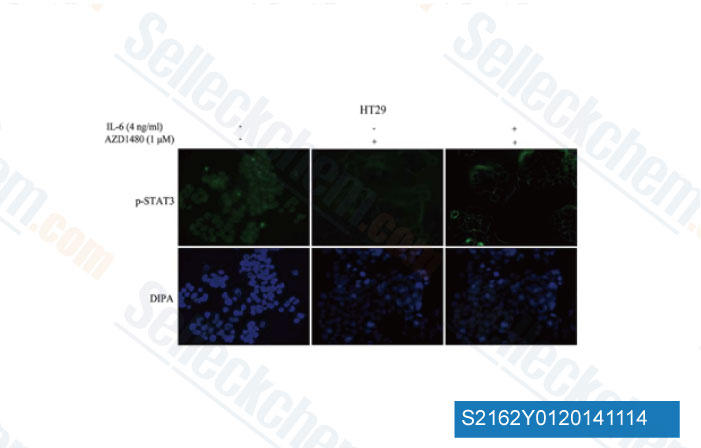|
Toll Free: (877) 796-6397 -- USA and Canada only -- |
Fax: +1-832-582-8590 Orders: +1-832-582-8158 |
Tech Support: +1-832-582-8158 Ext:3 Please provide your Order Number in the email. |
Technical Data
| Formula | C27H32N8O2 |
||||||
| Molecular Weight | 500.6 | CAS No. | 955365-80-7 | ||||
| Solubility (25°C)* | In vitro | DMSO | 100 mg/mL (199.76 mM) | ||||
| Water | Insoluble | ||||||
| Ethanol | Insoluble | ||||||
| In vivo (Add solvents to the product individually and in order) |
|
||||||
|
* <1 mg/ml means slightly soluble or insoluble. * Please note that Selleck tests the solubility of all compounds in-house, and the actual solubility may differ slightly from published values. This is normal and is due to slight batch-to-batch variations. * Room temperature shipping (Stability testing shows this product can be shipped without any cooling measures.) |
|||||||
Preparing Stock Solutions
Biological Activity
| Description | Adavosertib (MK-1775, AZD1775) is a potent and selective Wee1 inhibitor with IC50 of 5.2 nM in a cell-free assay; hinders G2 DNA damage checkpoint. Phase 2. | ||
|---|---|---|---|
| Targets |
|
||
| In vitro | MK-1775 inhibits Wee1 kinase in an ATP-competitive manner. Compared to Wee1, MK-1775 displays 2- to 3-fold less potency against Yes with IC50 of 14 nM, 10-fold less potency against seven other kinases with >80% inhibition at 1 μM, and >100-fold selectivity over human Myt 1, another kinase that inhibits cyclin-dependent kinase 1 (CDC2) by phosphorylation at an alternative site (Thr14). By abrogating the DNA damage checkpoint via blockade of Wee1 activity in WiDr cells bearing mutated p53, MK-1775 treatment inhibits the basal phosphorylation of CDC2 at Tyr15 (CDC2Y15) with EC50 of 49 nM, and suppresses induced phosphorylation of CDC2 and cell cycle arrest in a dose-dependent manner, with EC50 of 82 nM and 81 nM, 180 nM and 163 nM, as well as 159 nM and 160 nM, respectively. MK-1775 treatment alone at 30-100 nM has no significant antiproliferative effect in WiDr and H1299 cells, whereas MK-1775 at 300 nM, sufficient to inhibit Wee1 by >80%, displays moderate but significant antiproliferative effects by 34.1% in WiDr cells and 28.4% in H1299 cells. [1] |
||
| In vivo | MK-1775 treatment alone at ~20 mg/kg displays minimal antitumor effects against WiDr xenografts in rats with T/C of 69% at day 3. Antitumor efficacy by MK-1775 alone in the nude rat HeLa-luc and TOV21G-shp53 xenograft models is also moderate. [1] |
||
| Features | The first reported Wee1 inhibitor. |
Protocol (from reference)
| Kinase Assay: |
|
|---|---|
| Cell Assay: |
|
| Animal Study: |
|
Customer Product Validation

-
Data from [Data independently produced by J Hematol Oncol, 2014, 7:53]

-
Data from [Data independently produced by Oncol Rep, 2014, 32(5), 1991-8]

-
Data from [Data independently produced by Endocrinology, 2013, 154(9), 3219-27]

-
Data from [Data independently produced by PLoS One, 2013, 8(3), e57523]
Selleck's Adavosertib (MK-1775) has been cited by 257 publications
| A patient-derived T cell lymphoma biorepository uncovers pathogenetic mechanisms and host-related therapeutic vulnerabilities [ Cell Rep Med, 2025, S2666-3791(25)00102-8] | PubMed: 40147445 |
| SETD2 loss-of-function uniquely sensitizes cells to epigenetic targeting of NSD1-directed H3K36 methylation [ Genome Biol, 2025, 26(1):22] | PubMed: 39910618 |
| Cytoplasmic WEE1 promotes resistance to PD-1 blockade through hyperactivation of the HSP90A/TCL1/AKT signaling axis in NANOGhigh tumors [ Cancer Immunol Res, 2025, 10.1158/2326-6066.CIR-24-0379] | PubMed: 40067354 |
| Geometric deep learning and multiple-instance learning for 3D cell-shape profiling [ Cell Syst, 2025, 16(3):101229] | PubMed: 40112779 |
| Cyclin E1 overexpression sensitizes ovarian cancer cells to WEE1 and PLK1 inhibition [ Oncogene, 2025, 10.1038/s41388-025-03312-4] | PubMed: 39994376 |
| Characterization of a pleomorphic rhabdomyosarcoma cell line [ Sci Rep, 2025, 15(1):2893] | PubMed: 39843506 |
| Defining the KRAS- and ERK-dependent transcriptome in KRAS-mutant cancers [ Science, 2024, 384(6700):eadk0775] | PubMed: 38843331 |
| Synergistic induction of mitotic pyroptosis and tumor remission by inhibiting proteasome and WEE family kinases [ Signal Transduct Target Ther, 2024, 9(1):181.] | PubMed: 38992067 |
| Heterogeneity-driven phenotypic plasticity and treatment response in branched-organoid models of pancreatic ductal adenocarcinoma [ Nat Biomed Eng, 2024, 10.1038/s41551-024-01273-9] | PubMed: 39658630 |
| Comprehensive multi-omics analysis reveals WEE1 as a synergistic lethal target with hyperthermia through CDK1 super-activation [ Nat Commun, 2024, 15(1):2089] | PubMed: 38453961 |
RETURN POLICY
Selleck Chemical’s Unconditional Return Policy ensures a smooth online shopping experience for our customers. If you are in any way unsatisfied with your purchase, you may return any item(s) within 7 days of receiving it. In the event of product quality issues, either protocol related or product related problems, you may return any item(s) within 365 days from the original purchase date. Please follow the instructions below when returning products.
SHIPPING AND STORAGE
Selleck products are transported at room temperature. If you receive the product at room temperature, please rest assured, the Selleck Quality Inspection Department has conducted experiments to verify that the normal temperature placement of one month will not affect the biological activity of powder products. After collecting, please store the product according to the requirements described in the datasheet. Most Selleck products are stable under the recommended conditions.
NOT FOR HUMAN, VETERINARY DIAGNOSTIC OR THERAPEUTIC USE.
